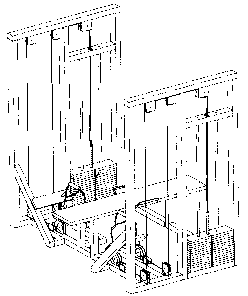Some of the information on this Web page has been provided by external sources. The Government of Canada is not responsible for the accuracy, reliability or currency of the information supplied by external sources. Users wishing to rely upon this information should consult directly with the source of the information. Content provided by external sources is not subject to official languages, privacy and accessibility requirements.
Any discrepancies in the text and image of the Claims and Abstract are due to differing posting times. Text of the Claims and Abstract are posted:
| (12) Patent Application: | (11) CA 2764275 |
|---|---|
| (54) English Title: | UPPER BODY EXERCISE EQUIPMENT |
| (54) French Title: | APPAREIL D'EXERCICES POUR LE HAUT DU CORPS |
| Status: | Deemed Abandoned and Beyond the Period of Reinstatement - Pending Response to Notice of Disregarded Communication |
| (51) International Patent Classification (IPC): |
|
|---|---|
| (72) Inventors : |
|
| (73) Owners : |
|
| (71) Applicants : |
|
| (74) Agent: | |
| (74) Associate agent: | |
| (45) Issued: | |
| (22) Filed Date: | 2012-01-16 |
| (41) Open to Public Inspection: | 2013-07-16 |
| Examination requested: | 2012-01-16 |
| Availability of licence: | N/A |
| Dedicated to the Public: | N/A |
| (25) Language of filing: | English |
| Patent Cooperation Treaty (PCT): | No |
|---|
| (30) Application Priority Data: | None |
|---|
This invention is an exercise equipment. It is used to exercise the upper
body, mainly
Chest, Arm and Shoulder muscles. With this equipment a different approach is
used to
exercise these muscle groups than with a conventional Bench Press (Bar-Bell)
for the
same muscle groups. This invention has the motions similar to a conventional
Bench-press.
But the weight is not on top/overhead of the Person but located on the Floor
on
either the sides or behind the bench connected through a cable or cables via a
Pulley
system with Handles attached to the other end of the cable.
One lies on the Bench, less than shoulders wide and pushes with the Hands the
two
Handles (one in either hand) up, until the elbows are locked, preferable in a
straight line
and then let back down slowly. The resistance is from the bottom somewhere
below the
shoulders where the first or last Pulley (depends how one traces the system),
in the Pulley
system, is located.
The weight is adjustable by a locking pin, which is inserted into the Holes of
the selected
weight.
Note: Claims are shown in the official language in which they were submitted.
Note: Descriptions are shown in the official language in which they were submitted.

2024-08-01:As part of the Next Generation Patents (NGP) transition, the Canadian Patents Database (CPD) now contains a more detailed Event History, which replicates the Event Log of our new back-office solution.
Please note that "Inactive:" events refers to events no longer in use in our new back-office solution.
For a clearer understanding of the status of the application/patent presented on this page, the site Disclaimer , as well as the definitions for Patent , Event History , Maintenance Fee and Payment History should be consulted.
| Description | Date |
|---|---|
| Application Not Reinstated by Deadline | 2016-01-18 |
| Time Limit for Reversal Expired | 2016-01-18 |
| Inactive: Abandoned - No reply to s.30(2) Rules requisition | 2015-02-16 |
| Deemed Abandoned - Failure to Respond to Maintenance Fee Notice | 2015-01-16 |
| Inactive: S.30(2) Rules - Examiner requisition | 2014-08-14 |
| Inactive: Report - QC passed | 2014-08-12 |
| Amendment Received - Voluntary Amendment | 2014-06-09 |
| Inactive: S.30(2) Rules - Examiner requisition | 2014-01-16 |
| Inactive: Report - No QC | 2014-01-14 |
| Amendment Received - Voluntary Amendment | 2013-10-02 |
| Maintenance Request Received | 2013-09-10 |
| Application Published (Open to Public Inspection) | 2013-07-16 |
| Inactive: Cover page published | 2013-07-15 |
| Inactive: S.30(2) Rules - Examiner requisition | 2013-04-10 |
| Inactive: IPC assigned | 2012-02-02 |
| Inactive: First IPC assigned | 2012-02-02 |
| Inactive: IPC assigned | 2012-02-02 |
| Inactive: IPC assigned | 2012-02-02 |
| Inactive: IPC assigned | 2012-02-02 |
| Inactive: Filing certificate - RFE (English) | 2012-01-30 |
| Inactive: Office letter | 2012-01-30 |
| Letter Sent | 2012-01-30 |
| Application Received - Regular National | 2012-01-30 |
| All Requirements for Examination Determined Compliant | 2012-01-16 |
| Request for Examination Requirements Determined Compliant | 2012-01-16 |
| Small Entity Declaration Determined Compliant | 2012-01-16 |
| Abandonment Date | Reason | Reinstatement Date |
|---|---|---|
| 2015-01-16 |
The last payment was received on 2013-09-10
Note : If the full payment has not been received on or before the date indicated, a further fee may be required which may be one of the following
Patent fees are adjusted on the 1st of January every year. The amounts above are the current amounts if received by December 31 of the current year.
Please refer to the CIPO
Patent Fees
web page to see all current fee amounts.
| Fee Type | Anniversary Year | Due Date | Paid Date |
|---|---|---|---|
| Request for examination - small | 2012-01-16 | ||
| Application fee - small | 2012-01-16 | ||
| MF (application, 2nd anniv.) - small | 02 | 2014-01-16 | 2013-09-10 |
Note: Records showing the ownership history in alphabetical order.
| Current Owners on Record |
|---|
| HELMUT FARMER |
| Past Owners on Record |
|---|
| None |